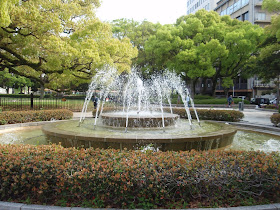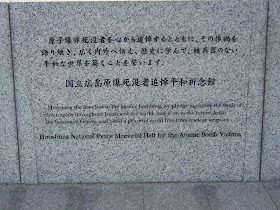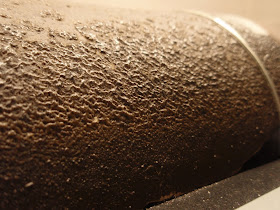Hiroshima was the first city I visited outside of the Tokyo/Yokohama area, way back in late April. I took an overnight highway bus that arrived around 8 in the morning, packed my luggage in a locker, and started my exploration of the city.
My main destination that day was the Peace Park and its surrounding memorials. I got off the tram right in front of the Genbaku Dome (now known as the A-Bomb Dome).While the entire park area is set aside as a place for rememberance, it's not so solemn a park.
The dome's empty shell is quite beautiful and is the most famous part of the park.
It's been restored/reinforced a few times to remain a lasting reminder of the first atomic bomb ever dropped.
There were several other tourists that day, but I also saw people and families just enjoying the park as a beautiful open space to walk and sit.
At around nine in the morning, the sun is in a great position to put some nice shadows on the building. I think the evening shadows could be even better.
The nearby waterway serves as a nice reflecting pool.
Next to the dome is a three-way bridge. Hiroshima's waterways give it an interesting layout.
Next to the dome were some pretty flowers.
This is a children's memorial.
Looking down the promenade from the dome, toward the museum.
In honor of one small girl who suffered from the bombing and made paper cranes, this outdoor museum holds thousands of paper cranes.
Some are arranged into flags/posters.
Others just hang like curtains.
There are thousands and thousands of cranes in the cases, mostly made by school children.
The museum.
The cenotaph; those who died as a result of the Hiroshima atomic bombing are remembered here. The chest beneath the arch holds a register of those who died from the blast or radiation.
Next to the cenotaph is the memorial hall.
The hall is below ground; the surface holds this memorial.
It represents a clock face stopped at 8:15, the time the bomb detonated. Surrounding it is rubble from the explosion.
This tree somehow survived the bomb. Actually, there are two trees here, chinese parasols. They were about 1300 meters from the hypocenter, but have been transplanted and protected here. There are several plants that survived the atomic bomb, and at least some have reproduced.
It's still growing nearly 70 years later. It didn't have its full summer leaves yet.
Inside the museum, there is a giant peace drum.
8:14
8:15
8:16
There are lots of artifacts in the museum and a great deal of information about the events leading up to and after the dropping of the bomb.About halfway through you "experience" what it's like to walk through Hiroshima after the bomb was dropped.
Then, you see effects of the bomb. Clothing damaged and bloody.
A child's favorite tricycle.
Steps from a bank with a darkened shadow where a person was vaporized.
A poster whose letters were burned out.
Roof tiles, the surface of which boiled from the blast.
Left side: covered; right side: uncovered.
Glass bottles fused together from the heat.
A view from the museum back to the dome.
After leaving the museum, I headed off in search of other buildings that survived the bombing. This is an elementary school just across the river from the dome.
Near the dome is this remembrance from the Hiroshima Gas Company.
A nearby bank.
Another elementary school which has been turned into another museum.
It tells the story of a survivor from the school. You can see burning from the heat on the inside.
If you look closely (enlarge the photo) you should be able to make out writing where survivors wrote their names so family members would know they were okay.
Paper cranes.
A couple doors damaged by the blast. I highly recommend that anyone going to the Peace Park also take a detour to this school. It should be listed on maps (to the east of the park) or ask at the museum's information desk.
Another building that survived the blast, in a nearby shopping district.
You can visit Peace Park and the surrounding memorials/surviving buildings in a full morning. While it's a very sad reminder of the destruction mankind does to itself (and America did to Japan), I feel visiting these sites was important to understand what happened and Japan's view of the event. It's interesting to see how much Hiroshima has really recovered as a city and grown around the park, when many thought the area would be inhabitable for decades.
Peace Park is 15 minutes from Hiroshima Station on tram line 2 or 6 (150 yen ride). Admission to the museum is 50 yen and it's open from 8:30 AM until 5, 6, or 7 pm depending on the season. All other locations shown here are free.



















































No comments:
Post a Comment